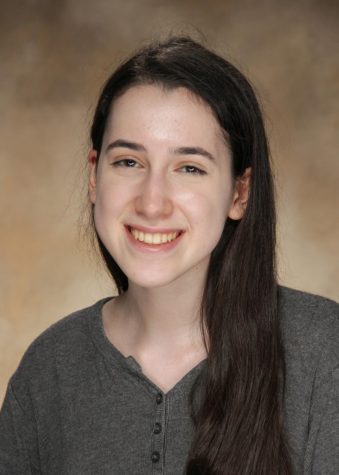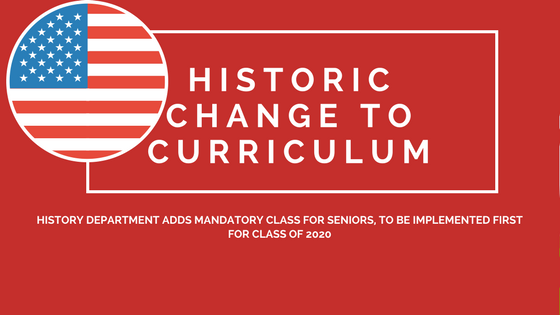Historic change to curriculum
History department adds mandatory class for seniors, to be implemented first for class of 2020
Starting in the 2019-2020 school year, the CESJDS history department will require seniors to enroll in a new course, 21st Century American Identity, rather than allow them to choose from elective options as they do now.
21st Century American Identity will first be introduced as an elective for the history distribution half-credit in the 2018-2019 school year. The administration initially indicated that the course would be required for current juniors in their senior year. A later email on Jan. 11 to the parents of the class of 2019 stated that after receiving feedback, it would still offer the class but delay its requirement for a year.
The course is structured thematically rather than chronologically. It starts with contemporary global issues, and it traces their roots back through the history so students can learn how historical trends have led to current conversations.
History Department Chair Mark Buckley said that teachers will choose broad themes such as global changes in foreign policy or race relations in the United States. The class will be student-centered and project-based. While discussions may vary between different class- es, there will be a standard general curriculum and skill-set addressed between all classes. Buckley said the new class will build off of the skills students have already developed throughout the first three years of high school.
“We want this to be a class where we put a lot of it on the students to sort of formulate the discussions and the way the course is going to be structured and look,” Buckley said.
Due to some overlap with the current Contemporary Issues class, that course will no longer be offered starting next year. Although the approach of the class and some topics will remain, Buckley said that 21st Century American Identity will not be exactly the same as Contemporary Issues.
“We’re going to do a little more history to develop that context so that students kind of get a sense of it and try and balance a little bit between the current and the historical,” Buckley said.
According to Academic Dean Aileen Goldstein, the introduction of the class at JDS has been a long process. She said that one of the major motivations for its creation was that, while the current required history classes offered by the school educate students
well, they do not necessarily connect to modern history and to today’s society.
Goldstein said that the school’s core values include graduating citizens of the world who are not only steeped in Jewish tradition but who also understand the democracy in which they live. The school wanted to help students better interact with the world around them, and this new class is oriented toward giving students the skills necessary for those interactions.
According to Goldstein, many other classes in the school have a similar approach to meeting this specific school value. These courses include classes in the Jewish history curriculum and in particular classes like Contemporary American Jewish Society as well as Jewish text classes like Theology. Skills learned in the general studies curriculum, such as critical thinking and student-driven research as applied to projects like the ISearch, further the school’s education of current issues.
The previous form of senior-year history, in which students chose which class they wanted to fulfill their distribution requirement, dates back to many years ago. According to Goldstein, there used to only be a three-credit requirement for history, so there were only electives offered senior year, one on Vietnam and one on art history. When the credit requirement changed to 3.5, more options were considered.
“The options that have grown, have grown very organically out of who’s in the department, as well as [out of] a look at what we want students to walk out with, but it’s sort of both of those simultaneously,” Goldstein said.
According to Buckley, while these options were interesting and offered unique historical perspectives, they were a specialized view of history and their content was more that of an elective class. Each course was also often tied to a certain teacher. This resulted in a wide array of courses which lacked a “final experience” that would be unified, as a history requirement would give, Buckley said.
Next year, in addition to the new course, American Women’s History, War and Civilization and Art History will still be offered to students, but all three options may not run depending on how many students register for each course.
Senior Lois Richman was enrolled in both Women’s History and War and Civilization. Richman liked that she was able to choose her his- tory courses this year, which will be lost if students cannot fit a history elective as well as their required history course into their schedules. Being able to choose what courses she wanted to take made Richman’s schedule more interesting, but she also appreciates the value of discussing current issues in history classes.
“I think that [Women’s History] is super current and I’m already be- ing able to engage in conversations that I probably wouldn’t have been able to engage in before, so I definitely think it prepares you a lot,” Richman said. “War and Civ is a little bit different because it’s not like I’m really talking about a lot of these battles or wars on a day-to-day basis, but that can also help too.”
The opportunity to learn about different historical perspectives is one that the school hopes to maintain, Goldstein said. The current history elective classes will also be offered to future juniors as well as seniors, which Goldstein said may lead to an uptick in how many juniors double in history.
“Right now there are a lot of options to go deep in science, but science isn’t for everybody and so this is a great opportunity for students that are interested in the humanities to go deeper in the humanities,” Goldstein said. “They can do it right now in science, they can do it right now in the Judaics, so we are now expanding that in the humanities beyond just the Creative Writing option.”
This story was featured in the Volume 35, Issue 4 print edition of The Lion’s Tale, published on January 31, 2018.








